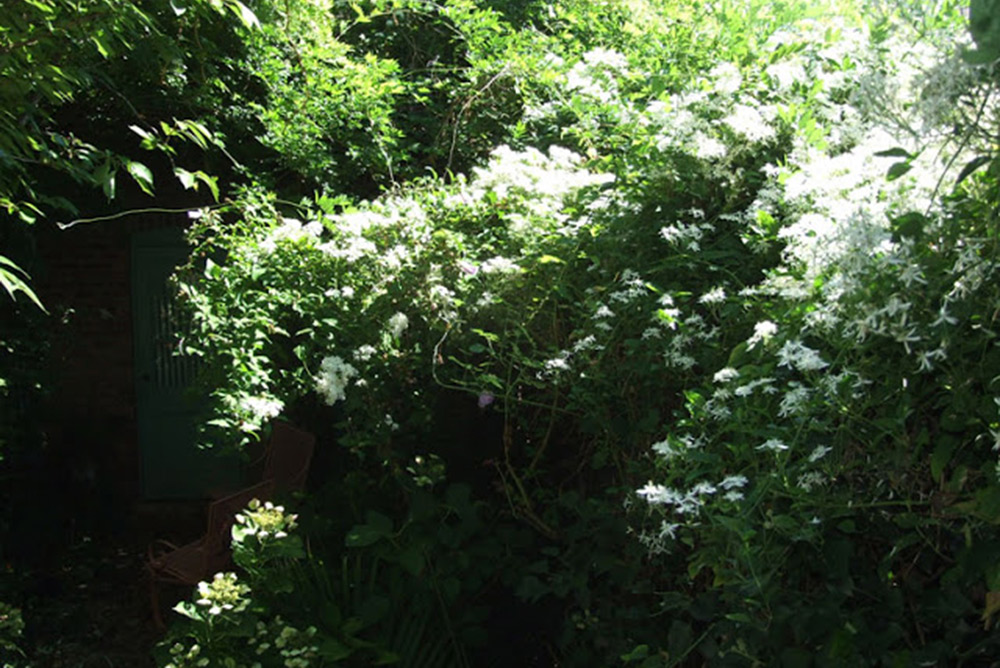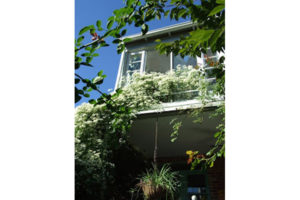
That wild white autumn clematis. / Photo by Stephanie Cavanaugh.
I WOULD RATHER be writing about the garden on some tropical beach—there has not been
nearly enough blue water and white sand this year.
But then I’d be missing this view, the juxtaposition of fences and railings
and frothy white flower vine, also known as autumn clematis. Were I still
floating face down in limpid tropical water going ooooh, yellow fishie! ooooh,
blue fishie! and so forth, it would all be over. The peak of bloom scarcely
lasts two weeks into September.
Some years the foamy flowering begins in the far right corner of the yard
where the vine has climbed the wisteria to flounce along the top of the
garage in one direction and along the fence to the house in the other.
There it normally climbs the drainpipe and intertwirls the coils of the
white iron railing of the little greenhouse off my second-floor office in an
explosion of white.
There is always a frisson of tension that this display will be abruptly
curtailed by The Prince during one of his wild flails with the clippers. We
are opposites when it comes to rampant, untamed growth. I can’t wait to see
where it will lead . . . he wants to whack it into submission.
Sadly, after just such a stealth pruning, this year the clematis merely dances along
the alley wall. Still wonderful, but not romping with its usual abandon.
This vine is a volunteer, unlike the one I actually bought some years ago, a
purple Nelly Moser clematis that went belly-up in some fit of pique, or
maybe went down screaming at a secret click of the secateurs.
Volunteer plants arrive here like fairy dust, floating in one day from who
knows where and taking delighted root. I say “delighted” because, unlike the
things I buy and then watch die, the volunteers arrive and tend to flourish.
This summer, Queen Anne’s Lace provided just such a fairy dusting, shooting
up out of nowhere in the front garden. At first I suspected it was a weed

The vine rampant, up to LittleBird Stephanie’s second-floor greenhouse. / Photo by Stephanie Cavanaugh.
(which it actually is) but decided on watchful waiting and lo! The lovely,
lacy, saucer-sized flowers eventually unfurled. It does look a tad ratty
when the flowers die, like a carrot when its foliage is left too long in the
fridge, an apt comparison since the plants are related. But it’s so splendid
when in flower—possibly because it’s another of those plants they tell you
Not To Plant, NO, not under any circumstances. Beware! Invasive!
Of course I’ve always craved them, digging up roadside patches and
attempting transplants year after year and failing miserably, or so I
thought. I suppose a seed or two sat and considered before adopting my
front patch as home.
As did the wash of purple flowers called lunaria that suddenly went mad in
the curbside garden this spring. Commonly known as money plant, or silver
dollar, the mass of purple blossoms gives way to disks covered in a stiff
brownish casing, the color of three-day-old scabs. Peel off the scab and
paper-thin, silvery seed pods are exposed. My mother used to fit these into
arrangements, maybe yours did too. Now I do.
They blew in from Joe’s yard. The “mayor” of our block spends a great deal
of time rocking on his heels on the sidewalk and chatting to whoever wanders
by. Recently retired, he’s cultivating his dotage, though he’s technically
still too young.
There are quite a number of neighbors who’ve lived here 30 or so years,
buying in when Capitol Hill was still relatively cheap, energetically fixing
old houses, raising their kids, and now saying codgery things to a new
wash of children when they’re not taking their exorbitant profits and moving
to South Beach or Austin to recapture wild youth.
Anyway. The lunaria appeared in Joe’s front yard some time ago and then this
spring in our sidewalk patch, which is, curiously, a considerable distance
from his. The seedlings had to fly across four yards and a sidewalk to land
where they are.
Less happily, a Rose of Sharon in a depressing shade of lilac poked forth
several years ago and is now a 10-foot tree. No doubt it’s an unfortunate
offshoot of the immense red and white Rose of Sharon that billows in a
corner next to the back porch, like an awning in the South of France, its
only good feature. It was another of those apology plants from my beloved
who did something, I forget what.
I don’t much like either, as they remind me of The Prince once removed, but
as they’re among the few plants that bloom from July until frost, I leave
them be.
—Stephanie Cavanaugh
LittleBird Stephanie is working on a book about urban gardening. To see earlier columns, type Green Acre into the Search box at the top right of the page.
